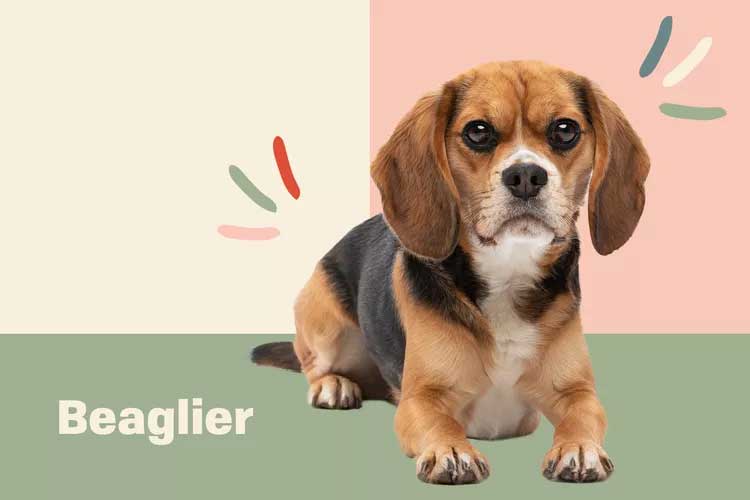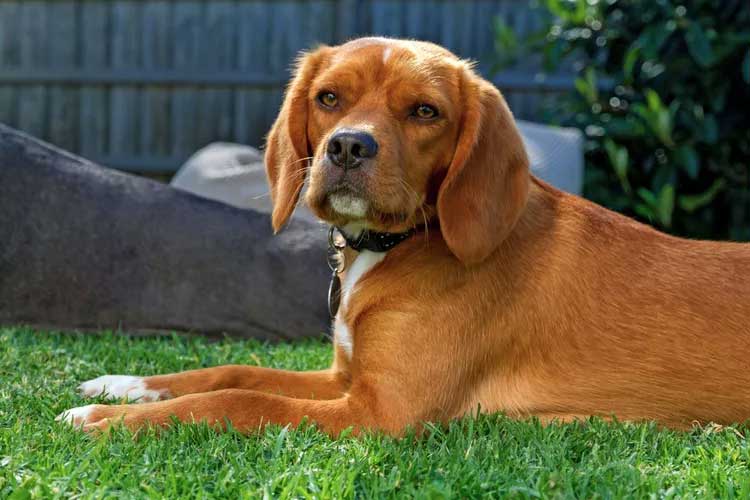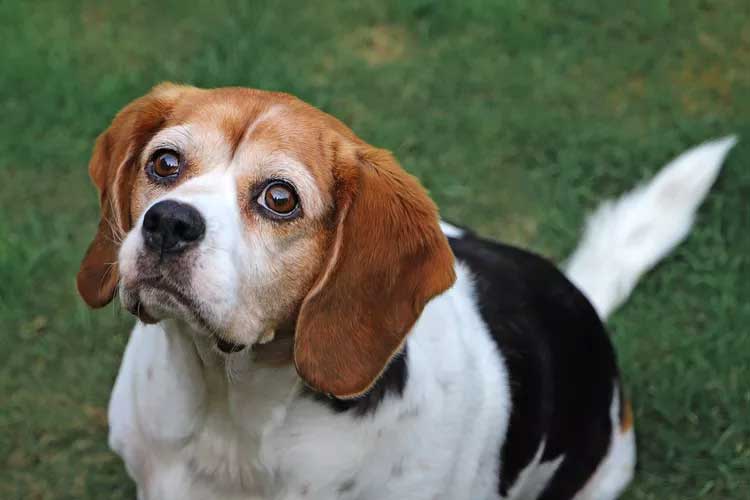Beagliers are a cute cross between a beagle and a Cavalier King Charles spaniel. Learn more about living with these friendly, sweet-eyed pups.

Beaglier Overview
| OFFICIAL NAME | Beaglier |
| COMMON NAME | Beaglier |
| PET HEIGHT | 12 to 15 inches |
| PET WEIGHT | 13 to 30 pounds |
| LIFESPAN | 10 to 18 years |
| GOOD WITH | children, dogs, families, seniors |
| TEMPERAMENT | friendly, gentle, outgoing, playful |
| INTELLIGENCE | high |
| SHEDDING AMOUNT | occasional |
| EXERCISE NEEDS | medium |
| ENERGY LEVEL | active |
| VOCAL LEVEL | when necessary |
| DROOL AMOUNT | low |
| BREED GROUP | hybrid |
| BREED SIZE | small (0-25 lbs.) |
| COAT LENGTH | medium, short |
| COLORS | black, blue, brown / chocolate / liver, red, white |
| PATTERNS | bicolor, black and tan, tricolor |
| OTHER TRAITS | apartment-friendly, easy to groom, easy to train, good for first-time pet owners, good hiking companion, high potential for weight gain |
The beaglier, or beagle Cavalier mix, is a hybrid breed that combines the playfulness of the beagle with the sweetness of the Cavalier King Charles spaniel. These dogs are small in stature, affectionate, and outgoing. This makes them a perfect fit for nearly all households, including first-time pet parents. Beagliers are relatively uncommon in the United States, though there are a handful of beaglier breeders across the country.
"Happy, outgoing, and confident, these dogs love to be around their family," says Linda Simon, MVB, MRCVS, consulting veterinarian at FiveBarks. "They are energetic and like to get in on the action."
Appearance
A beaglier is a cross between a beagle and a Cavalier King Charles spaniel, two very popular breeds in their own right. These designer dogs are petite and utterly adorable, thanks to expressive eyes, supremely soft coats, and floppy ears.
Mixed breed dogs can inherit a variety of traits from both parents, including how they look. Cavalier King Charles spaniels usually stand 12–13 inches tall and weigh 13–18 pounds, while beagles are 13–15 inches tall and weigh 20–30 pounds. A beaglier will fall somewhere in between.
Beagliers may inherit the smooth and short coat of the beagle, the silky medium-length locks of the Cavalier King Charles spaniel, or some combination of the two. They may also have coats that mirror the colors of their parent breeds—typically some combination of black, blue, tan, white, or red.
Their triangular-shaped ears tend to hang down the sides of their faces, and their snouts are usually short to medium-length. Beagliers tend to have dark eyes that communicate exactly what they are thinking and feeling (and they're nearly impossible to resist when he's staring hopefully at the treat jar).
Temperament
With beagliers, owners get the best personality traits of both beagles and Cavalier King Charles spaniels, says Corinne Wigfall, DVM, BVS, BVM, and consulting veterinarian with SpiritDog Training. "Their personality type can be varied depending on the hybrid mix they are, and which breed is more predominant in the cross, either the beagle or Cavalier," she says.Beagles are friendly, playful, curious, and highly intelligent. They're best known for their extremely powerful noses, which can follow even the faintest of scents. These vocal pups also have a tendency to bark and bay. Cavalier King Charles spaniels are affectionate, people-loving lap dogs who love nothing more than spending time with their human family members.
Beagliers share many of these same characteristics with their parent breeds. They're sweet, outgoing, adaptable, energetic, and altogether fun to be around. Overall, beagliers make ideal companions for families, seniors, young professionals, and just about everyone in between.
Living Needs
Beagliers are adaptable and, because of their small size, they can live in a variety of settings—studio apartments, rural farms, high-rise condos, and single-family homes are all comfortable for beagliers.That being said, no matter where they live, beagliers need regular exercise to stay healthy and in good spirits. This can be walks in the park, playtime in the living room, games of fetch in the backyard, or even short day hikes. Like beagles and Cavalier King Charles spaniels, beagliers can be good contenders for dog sports and activities including agility, obedience, and field trials.
"The beaglier is a good match for a young family, if they can be provided with enough exercise," Simon says. "They love the opportunity to sniff, track, and explore. If you take them along on your morning jog, they'll be your best friend for the rest of the day."
Their small size also makes it extra important for parents to teach young children how to respect and handle pets with care. They make great companions for children, but beagliers are petite enough that kids may inadvertently hurt them. To avoid any pulled tails or ears, parents should always be around to supervise interactions between beagliers and children.
Beagliers can do well with cats and other dogs, but it really comes down to the individual dog (though the Cavalier King Charles spaniel has a low prey drive, the beagle has a high prey drive—and a beaglier may take after one parent more than the other). Owners should socialize beaglier puppies with household cats and other dogs so they understand that these other animals are their furry brothers and sisters.

Like both Cavalier King Charles spaniels and beagles, these pups absolutely love to be near their owners. Though they can tolerate being left alone for a little while, they would really prefer to be in your company at all times—they shouldn't be left alone for too long, whenever possible. Getting another pet to keep them company, hiring a pet sitter or dog walker, or bringing your dog along as you run errands can help put your beaglier at ease and lessen his separation anxiety.
While beagliers want to please their owners, they can have a bit of an independent streak. When it comes to training, short and engaging sessions with high-value rewards (like treats, a favorite toy, petting, and effusive praise) are the way to go for beagliers. Be patient, be consistent, and all this positive reinforcement training will pay off.
"Training the beaglier can be incredibly rewarding," Simon says. "Not only are they smart and eager participants, but they are also highly food-driven. They'll happily cooperate as long as tasty treats are on offer as a reward."
Owners should start training their beaglier early and often. Not only does this help reinforce good behaviors from a young age, but it also stimulates the highly intelligent beaglier's brain, which helps keep him relaxed and on his best behavior (food puzzles and interactive toys can help with this too).
Beaglier puppies make great students at training classes. At puppy kindergarten, a knowledgeable trainer can help you and your pooch master basic cues; the classes are also a great way to socialize your dog with other pets and humans as well as help him become comfortable with unfamiliar sights, sounds, noises, and smells.
Care
Beagliers may have the short, waterproof coat of the beagle parent or the mid-length waves of the Cavalier King Charles spaniel parent—it all comes down to genetics. Either way, beagliers are relatively low-maintenance dogs who need regular brushing to remove loose, dead hairs and debris. They also look and smell their best when they get a bath as needed.
For clean teeth and fresh breath, pup parents should brush their beaglier's teeth nightly (or at least a few times a week). It's also a good idea to discuss dental hygiene with your vet, who may recommend bringing your beaglier in for professional deep cleanings.
To keep their paws in tip-top shape for walking and playing, beagliers need their nails trimmed to a comfortable length regularly, either with clippers, a grinder, or some combination of both. Cleaning their ears regularly can also help prevent dirt, debris, and bacteria from building up.
Health
These happy-go-lucky dogs are generally a healthy breed, with average life spans ranging a lengthy 10–15 years. Still, they may inherit some of the genetic health problems that their parent breeds have.Responsible beagle breeders test for a genetic disease called Musladin-Lueke Syndrome (MLS), hip dysplasia, eye conditions, autoimmune thyroid disease, and heart issues. Cavalier King Charles spaniels also have a fair share of potential health issues, including Syringomyelia (SM), mitral valve disease (which can lead to heart failure), and idiopathic asymptomatic thrombocytopenia.
This list can look scary, but it's important to know your beaglier may not be affected by these health problems at all—it just depends on his parents.
Though breeders of purebred dogs typically follow a set of nationally recognized standards to help keep the breed healthy and free from issues, these same protocols don't always exist when it comes to designer or hybrid breeds.
There is no national breed club for beagliers in the U.S., so you'll need to do your own thorough research and vetting when it comes to finding a beaglier breeder. Proceed with caution and keep an eye out for red flags.
History
Though not much is known about this designer breed's history, beagliers were first developed in Australia in the 1990s. "The thought behind this cross was to achieve an energetic breed without as much hunting hound instinct as the beagle," Wigfall says.Beagliers remain most popular in Australia but are starting to catch on elsewhere around the world, including in the U.S. But their two parent breeds are highly popular and have long histories.
Beagles can be traced back to 200 A.D. in England, according to The National Beagle Club of America. Over the centuries, these hound dogs became a favorite among hunters for tracking prey. Beagles made their way to the U.S. after the Civil War where they quickly grew in popularity.
Cavalier King Charles spaniels date back to the 16th Century, according to the Cavalier King Charles Spaniel Club, and were named after King Charles II. The breed saw a surge in interest in the 1920s and they came to the U.S. in 1956.
Fun Facts
Beagliers are vigilant watchdogs, ready and willing to alert you whenever something seems amiss. They may bark when someone walks up to the door or they notice movement outside the window.This breed loves to eat! This helps with training but can also lead to an unhealthy weight. It's important for owners to monitor their beaglier's food and treat intake, provide plenty of exercise, and chat with a veterinarian about how to reach and maintain a healthy weight.
Beagliers typically have slightly less prey drive and sniffing powers than beagles, but those traits are definitely still there. Ensure your home's yard is fenced and always walk your beaglier on a leash—otherwise, he may be inclined to follow his nose or chase a rabbit through the neighborhood.